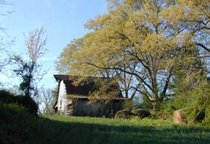A red-letter day in the life of a beekeeper -- the first swarm.
That happened to me on Thursday (April 17). Sally called in the middle of the day saying there was a pineapple-sized cluster of bees on the limb of an old tree about 30 or 40 feet from where the hives are located.
I got there as soon as I could get away, on my way trying to remember all the things I had read about gathering swarms and what had been mentioned at the last beekeepers association meeting about them.
Swarms are clusters of bees that have raised a new queen and left the hive. They are looking for a new home, and chances are they will gather initially some place very close to the hive they left. Beekeepers try to prevent their hives from breaking into swarms, but when they do, they realize that they have a new colony, and they have to deal with it. That's why its a good idea to have extra hive equipment -- boxes, frames, etc. -- on hand.
At least I had done that.
A swarm isn't that hard to capture. The bees are clustered and surprisingly benign. They are unlikely to sting. They're looking for a new home and not interested in protecting anything. If you can reach it, a swarm can be gathered by hand. You just have to have a box ready to put the bees in and a way to close the top so they won't fly out again. Then you need to have hive boxes ready, so the bees can be dumped into their new home. If the queen is in the hive box, the rest of the bees will follow.
That last point -- get the queen and the rest will follow -- was the principal one that I remembered. The swarm I had on Thursday gathered around a tree branch about eye level, so it was easy to reach once I had taken out a few blackberry vines. I gathered them into my hands and put them directly into the hive box. I probably got the queen on that first gathering, but I couldn't be sure. Sally found a cardboard box for me, and I gathered the bees that were left as they kept clustering around the branch. This went on for about an hour until there were few bees left, and I was pretty sure the queen was in the hive box.
Then I closed the box and waited. By that evening, none of the bees were left outside, so I was sure I had gotten the queen and most of the bees.
As I said before, beekeepers love to get swarms. They are easy and free way to start a new colony. (A box of bees would cost about $70.) Once inside a new hive, the bees have a natural tendency to draw comb, and any beekeeper will tell you that drawn comb is "pure gold."
Unfortunately, I didn't have my camera with me when the swarm occurred, so I don't have any pictures. The pictures I do have are of the third hive that contains the new colony. I set that hive up on its stand yesterday, put a jar of food for the bees on it, put a new box of frames on top of the one they already had, and now they are doing their thing. If the rain stops today, I may get a chance to look inside and see what's happening.
Here are links to a couple of good articles about swarms in Beemaster and Essortment in case you're interested in knowing more about swarms.
Saturday, April 19, 2008
My first swarm
Subscribe to:
Post Comments (Atom)



No comments:
Post a Comment